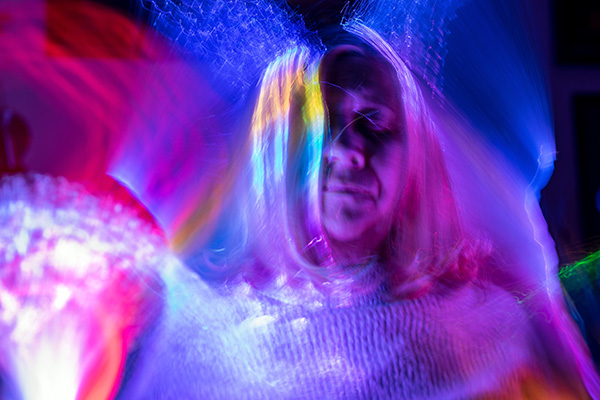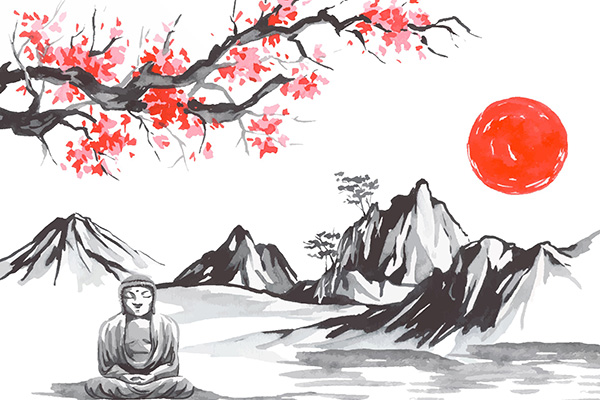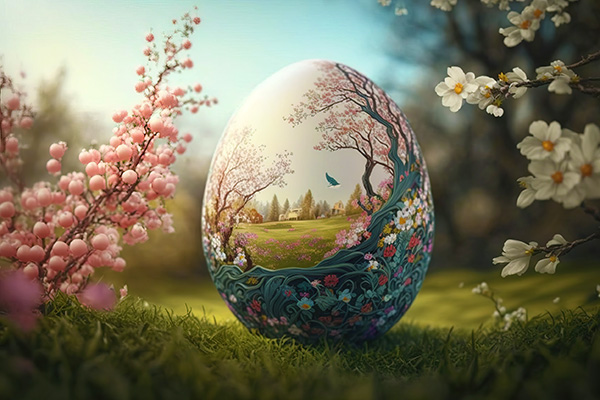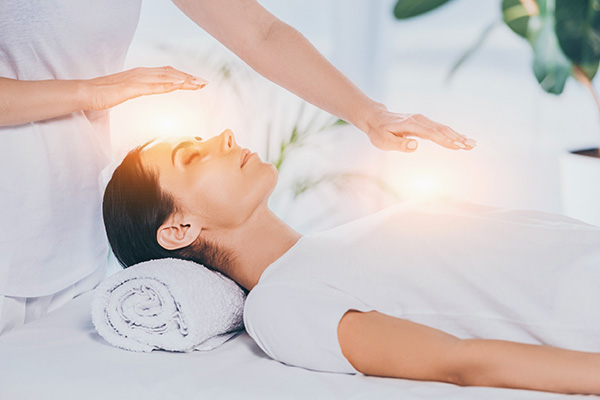A Simplified Guide to Mastering the Art of Aura Reading
 All beings possess both a tangible form and an intangible form known as the metaphysical body. This energetic manifestation, often referred to as the aura or light body, originates from and envelops the physical body.
All beings possess both a tangible form and an intangible form known as the metaphysical body. This energetic manifestation, often referred to as the aura or light body, originates from and envelops the physical body.
The aura is a subtle energy field made up of luminous colored layers of energy that radiate from a few inches to a few feet around us.
It is referred to by various terms in diverse spiritual and esoteric practices, such as psychic atmosphere, biofield, odic force, or etheric body.
Our aura reflects our health, emotions and mental state. Its energetic colors change according to our mood or well-being. Some traditions describe the auric layers with specific meanings, while others focus more on the different colors and their interpretations.
The aura consists of a form of energy called prana, chi, or qi, which is also known as life force energy. This energy moves within the body through pathways or channels that align with the energy meridian system in Traditional Chinese Medicine and the chakra system in Hindu, Buddhist, and Yogic practices.
The energy surrounding a person, known as the aura, is made up of various layers or fields. Each layer holds its own traits and importance, encompassing aspects like physical, emotional, mental, and spiritual aspects. Nevertheless, the interpretation of the number and composition of these layers varies across different traditions.
You can learn to do aura reading on people, pets, plants. If it has consciousness, it has an aura ~ Rose Rosetree
The connection between the aura and color is one of its most well-known features. The colors of the aura vary depending on an individual’s thoughts, emotions, physical well-being, and spiritual condition. Each color is linked to specific qualities or elements of awareness. For instance, blue can indicate tranquility and lucidity, whereas red may signify intense emotions or passion.
The aura holds significance in assessing an individual’s holistic health and wellness. Disruptions or disparities in our auric energy may present as challenges in the physical, emotional, mental, or spiritual realms. Methods such as purifying, aligning, and mending the aura can be employed to reintroduce unity and vigor to our mind, body, and spirit.
While the aura is generally invisible to the untrained eye and not easily observable by conventional means, one can learn to perceive and interpret it through aura reading to identify the colors, patterns and qualities of someone’s aura.
Aura reading or auric scanning is very useful for a number of reasons. It can provide insight into your emotional state, energy levels, physical health and general well-being.
Aura reading is a versatile tool that facilitates introspection and personal advancement. Many individuals find it valuable for decision-making, as it uncovers concealed aspects or motivations related to a given situation. Moreover, aura reading serves as a potent method for spiritual progress, karmic healing, and soul expansion.
I am confident that anyone has the potential to acquire the ability to perceive auras. This capability can be cultivated through consistent practice and unwavering commitment, similar to acquiring any other skill. While certain individuals may possess a higher level of natural intuition towards perceiving subtle energies or an inherent psychic talent for visualizing auric energies, reading auras can be learned by anyone willing to invest time and dedication.
My aura acts as a compass, leading me toward people and experiences that elevate my spirit and bring out the best in me ~ Linda Mc
Guidelines For Aura Reading
To enhance your skill in aura reading, you must cultivate your capacity to observe and understand delicate energies. Below are a few basic guidelines to help you commence your practice:
Awareness: Begin by developing your awareness of and sensitivity to subtle energies. The first step is to quiet your mind. This includes practices such as meditation, mindfulness, breath work or energy awareness exercises. Pay attention to your own energy field and the sensations you experience when interacting with others.
Education: Familiarise yourself with the concept of auras, including different theories, interpretations and descriptions of the colors, layers and meanings of the aura. There are many books, online resources and courses on the subject that can provide valuable insight and guidance.
Visualisation: Visualisation is a key skill in aura reading. Close your eyes and imagine a person standing in front of you. Visualise their energy field extending from several centimetres to several metres outwards from their body. Experiment with visualising different colors, textures and patterns in their aura.
Trust your intuition and follow your inner guidance while practicing aura reading. Notice any impressions, feelings, or insights that arise as you focus on a person’s energy field. It is not important to be correct or incorrect; the key is to stay open and receptive to whatever you perceive.
Start honing your aura reading skills by beginning with yourself. Look into a mirror or observe your hands and feet. As you become more comfortable, move on to practicing with friends, family, and other willing participants. Request them to stand or sit in front of you while you concentrate on their energy field. You can even try practicing on your plants or a pet, as long as they remain still for a sufficient amount of time.
Feedback: Share your aura reading experiences with others and ask for feedback on your observations. This can help you validate your perceptions and gain insights from different perspectives. Be open to constructive criticism and use it as an opportunity for growth and learning.
Journaling: Keep a diary or record of your aura reading experiences. Write down any colors, sensations, impressions or insights you receive during your practice sessions. Over time, you may begin to notice patterns or correlations between certain colors or qualities and people’s states of being.
Remember that aura reading is a highly subjective and personal practice, and there’s no one “right” way to do it. Trust your own abilities and intuition, and approach the practice with openness, curiosity and respect. Like any skill, aura reading takes time to master. Stay curious, keep exploring different techniques and approaches, and remain open to expanding your understanding of the aura and subtle energies.
Beautiful people don’t need coats. They’ve got their auras keeping them warm ~ Jennifer Donnelly
How To Do Basic Aura Reading
A room that is brightly illuminated and has a white backdrop is most suitable for beginners. Let your gaze traverse the subject gradually, causing a slight blurring effect. The initial thing you may notice is the internal aura, which typically manifests as a faint outline encircling the head and shoulders.
Once you have mastered the initial stage, start honing your ability to perceive a broader spectrum. Gradually, you will be able to discern hues that extend beyond the primary white circles. At the beginning, these shades might appear subtle, but fret not.
It is normal to observe varying colors in different areas of your body, which correspond to different chakras or levels of consciousness. It is possible for a person or animal to possess multiple colors within their unique aura.
Attempt to approach your aura reading with a neutral perspective. Since you constantly perceive your own aura, emotions like anger, depression, or sadness will influence your interpretation. A more harmonious mental state will result in a more accurate reading.
As a beginner, it might require some time for you to perceive darker colors like blue or purple. It is important to stay patient and continue practicing without getting discouraged. Additionally, avoid allowing the opinions of others to greatly affect you. Every individual is unique, and so are their auras.
If you are looking to have your aura read but do not want to learn how to do it yourself, seek out a skilled and trusted reader in your vicinity. Additionally, a professional reader might be open to assisting you in honing your own aura reading abilities.
|
Mystic Shelley is a highly regarded psychic practitioner who possesses various abilities, including being a five-star psychic, Reiki healer, clairvoyant, and empathic reader. She provides sincere insights to her clients about past, present, and future occurrences, thanks to her trusted guides. Mystic Shelley specializes in love, relationships, career, finances, and all aspects of life. While she was born with innate psychic talents, it took meeting a renowned psychic in her 30s to truly awaken and cultivate her gifts. Under the mentorship of this psychic, she harnessed her clairvoyance and empathy, elevating her skills to new heights. As she gained experience, her proficiency grew, resulting in a loyal client base who greatly appreciate her work. Additionally, Mystic Shelley actively assists other psychics in developing their own abilities. If you seek straightforward and candid answers, consider scheduling a reading with Mystic Shelley through PsychicAccess.com. |
A Simplified Guide to Becoming Proficient in Aura Reading
Have you ever been curious about the energy that surrounds people? Have you ever felt a certain vibe or aura when meeting someone for the first time? Aura reading is an ancient practice that allows individuals to tap into the energy fields surrounding living beings. It can provide valuable insights into a person’s emotional, mental, and spiritual state. If you’re interested in aura reading and want to learn how to excel in this art, this simplified guide will help you get started.
Understanding Auras:
Before diving into the art of aura reading, it’s crucial to comprehend what an aura is. Auras are subtle energy fields that surround living beings, including humans, animals, and plants. They are believed to be made up of electromagnetic energy and can extend several feet from the body. Auras are often described as colorful, luminous, or transparent. Each color represents different aspects of a person’s personality, emotions, and overall well-being.
Preparing for Aura Reading:
To embark on your aura reading journey, it’s important to create a calm and focused environment. Find a peaceful space where you won’t be interrupted. Adjust the lighting to create a soothing atmosphere, either by dimming the lights or using candlelight. Take a few deep breaths to relax your mind and body. It’s also helpful to cleanse your own energy by meditating or practicing deep breathing exercises before attempting to read someone’s aura.
Observing Auras:
To read someone’s aura, it is crucial to observe their energy field. Begin by focusing on the person’s body, particularly their head and shoulders. Soften your gaze and look beyond their physical form. You may notice a subtle glow or haze surrounding them. Pay attention to any colors, shapes, or movements you perceive. It’s important to trust your intuition and not overanalyze what you see.
Interpreting Aura Colors:
Once you start perceiving colors in someone’s aura, it’s time to interpret their meaning. Here are some common aura colors and their associated characteristics:
1. Red: Indicates passion, energy, and strong determination. It may also suggest anger or stress if it appears intense or unclear.
2. Orange: Represents creativity, enthusiasm, and vitality. An orange aura is often present in charismatic individuals.
3. Yellow: Signifies intelligence, optimism, and a curious nature. People with a yellow aura often possess analytical and logical thinking skills.
4. Green: Symbolizes balance, growth, and healing. Individuals with a green aura are often nurturing and compassionate.
5. Blue: Reflects calmness, communication, and spiritual awareness. A blue aura is commonly found in those who are intuitive and empathetic.
6. Purple: Indicates spirituality, intuition, and a higher level of consciousness. People with a purple aura often have psychic abilities or a strong connection to the spiritual realm.
7. White: Represents purity, clarity, and a divine connection. A white aura suggests a highly evolved soul or a person on a spiritual journey.
Remember that these interpretations are general guidelines, and each person’s aura is unique. It’s important to consider the overall context and other factors before jumping to conclusions.
Developing Your Skills:
Like any skill, becoming proficient in aura reading requires practice and patience. Start by practicing on yourself or close friends and family members whose energy you are familiar with. Take notes of your observations and compare them with the person’s current emotional or mental state. Over time, you will become more attuned to accurately reading auras.
Approach aura reading with an open mind and heart. Remember that it is a tool for understanding and connecting with others on a deeper level, rather than a means of judging or manipulating. Respect the privacy and boundaries of others when practicing aura reading.
In conclusion, becoming proficient in the art of aura reading can be an intriguing journey of self-discovery and understanding others. By learning to observe and interpret the subtle energy fields surrounding individuals, you can gain valuable insights into their emotional, mental, and spiritual well-being. With practice and an open mind, you can unlock the hidden world of auras and enhance your ability to connect with others on a profound level. Continue reading







